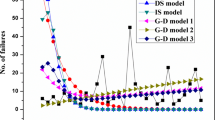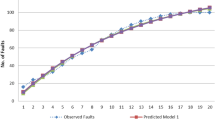Abstract
Failure rate parameters exert a great deal of influence on the accuracy of software reliability predictions. Thus, it behooves us to examine the methods that are used to estimate the parameters. The value of parameters is determined by the pattern of historical failure data and the amount of data used in the estimates. Conventional wisdom suggests that all the data be used. However, this could be counterproductive if all the data are not representative of the current and future failure process. Therefore, we can analyze these factors to obtain the optimal parameter estimates, where “optimal” means parameter values that will result in minimum prediction error. We examine one software reliability model that does not use all the failure data if a priori analysis indicates that optimal parameter values could not be obtained. Historically, this model has used a mean square error criterion (MSE) of the difference between actual and predicted reliability in the parameter estimation range. However, it has been observed that this policy does not always result in minimum error predictions in the prediction range. Therefore, we investigated the linear interpolation estimation method as an alternative to MSE for three NASA shuttle flight software releases comprising forty-two reliability predictions. Interestingly, linear interpolation provided better prediction accuracy, overall. We believe our analysis can be applied to other software and failure data. In order to systematize our thinking on developing new models using linear interpolation, we employed object-oriented design concepts as guides to implementing C++ programs for evaluating linear interpolation with respect to MSE.
Similar content being viewed by others
References
Bell D (2003) UML basics, Part II: The activity diagram. IBM Global Services, Rational Software
Bell D (2003) UML basics, Part III: The class diagram. IBM Global Services, Rational Software
Dorn WS and McCracken DD (1972). Numerical methods with Fortran IV case studies. Wiley, New York
Douglass BP (1999). Real-time UML: developing efficient objects for embedded systems. Addison-Wesley, Reading
Farr WH, Smith OD (1993) Statistical modeling and estimation of reliability functions for software (SMERFS) Users Guide, NAVSWC TR-84-373, Revision 2, Naval Surface Warfare Center, Dahlgren
Meyer B (1997). Object-oriented software construction. Prentice-Hall, Englewood Cliffs
Objecteering Free Edition
Schneidewind NF (1997). Reliability modeling for safety critical software. IEEE Trans Reliab 46(1): 88–98
Schneidewind NF (2007). Predicting software reliability with parameter evaluation. In: Webster, John G. (eds) Wiley encyclopedia of electrical and electronics, engineering (online), pp. Wiley, New York
Ullman L, Singer A (2006) C++ Programming. Peachpit Press
Author information
Authors and Affiliations
Corresponding author
Additional information
The author is a fellow of the IEEE, an IEEE Congressional Fellow, and a member of the US Senate 2005.
Rights and permissions
About this article
Cite this article
Schneidewind, N.F. Finding the optimal parameters for a software reliability model. Innovations Syst Softw Eng 3, 319–332 (2007). https://doi.org/10.1007/s11334-007-0029-9
Received:
Accepted:
Published:
Issue Date:
DOI: https://doi.org/10.1007/s11334-007-0029-9




